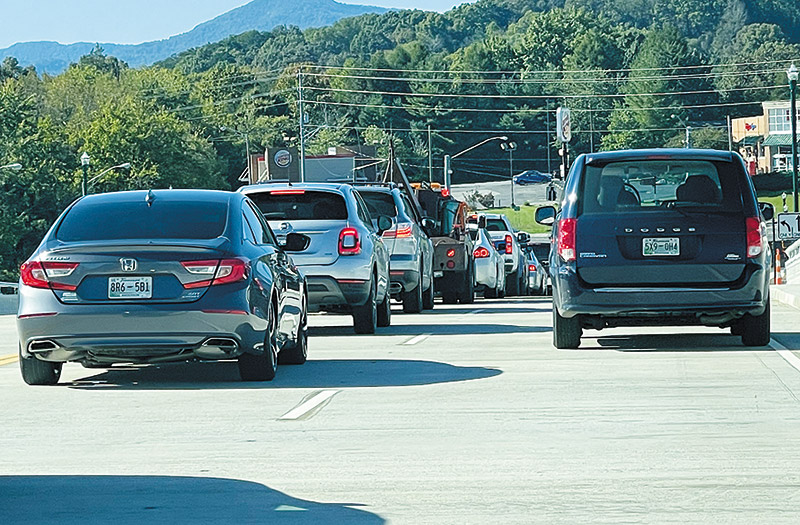Deck work continues on new bridge

Traffic backups, such as this one on Monday afternoon for northbound motorists, are common on the new Clinch River bridge in Clinton as work continues on the bridge deck. Not all lanes are open yet, and traffic jams are expected to continue until the work is finished. (photo:G. Chambers Williams III )
Traffic was switched onto the new span at 4 a.m. Tuesday, Oct. 12.
The bridge now has two lanes flowing in each direction, which expands to three lanes on the northbound side as it approaches Charles G. Seivers Boulevard.
But there are just single turn lanes in each direction, and one straight-through lane to Main Street for northbound traffic, which is causing some backups and delays, especially during heavy traffic periods.
Eventually, there will be two left-turn lanes to head toward Oak Ridge, two straight-through lanes, and a single right-turn lane to go toward Interstate 75.
What’s maybe even worse traffic-wise is what southbound motorists face, with just one left-turn lane coming from Oak Ridge and from I-75, and a single straight-through lane from Main Street onto the bridge.
Mid-afternoon on Monday, traffic was backed up about four blocks on Main Street waiting to get onto the bridge, and there were backups in the Seivers Boulevard turn lanes, as well, especially coming from I-75, although not as long.
Eventually there will once again be dual straight-through lanes from Main Street onto the new bridge, and dual left-turn lanes from westbound Seivers Boulevard onto the bridge. There will be only one right-turn lane from eastbound Seivers onto the bridge, which flows better anyway because of the right-turn-on-red policy.
Lynn Murphy, the city of Clinton’s liaison with the Tennessee Department of Transportation on the bridge project, explained the current traffic flow and remaining work to be done in an email to The Courier News.
“The current traffic plan and lane arrangement is a temporary one, and does not include the proposed center divider lane and two bike lanes,” he said. “The unused portion of the total bridge width will be used to continue work on the new bridge and both asphalt approaches. It will serve as a safe staging area for construction personnel and work vehicles.”
Some motorists who have used the bridge also have complained that the bridge is not as smooth as they thought it would be.
There’s a reason for that: Some of the paving has not been completed yet, Murphy said.
“The asphalt pavement on both bridge approaches requires an additional one-inch thick lift of asphalt topping,” he said. “This will improve the ride, particularly where the additional asphalt layer will smooth the transition between the concrete bridge deck and the asphalt approaches, where expansion joints are installed.”
Additionally, “Prior to opening the full width of the new bridge, the concrete bridge deck will have one-half inch deep grooves milled into the surface at staggered intervals, only a few inches apart, designed to aid with drainage and skid resistance,” Murphy said.
“When the bridge deck and approaches are ready for their full width to be utilized, new thermoplastic pavement markings and traffic control signs will be installed, creating the eight-feet-wide dividing buffer to separate opposing traffic lanes, and a four-feet-wide bike lane traveling in each direction.”
Murphy said the street lighting on the new bridge “will be operating soon, and the bridge handrails are being painted to match the color of the street light poles (green).”
As for the approaches, he said:
“The current temporary plan for northbound traffic is using one left-turn lane, one straight through lane, and one right-turn lane. The permanent traffic plan has two exclusive left-turn lanes toward Oak Ridge, two straight through lanes onto South Main Street, and one exclusive right-turn lane toward Norris.”
He added: “One sidewalk on the new bridge is now open and functional, on the northbound side.”
In a report to the city on Aug. 24, Murphy, said:
“The three-year contract between TDOT and Blalock for both the construction of a new bridge and the demolition of the old bridge (for $27,735,614.56) expires on August 31, 2021. Obviously, the remaining work will take several months to complete.”
Murphy said the bridge replacement project began Sept. 17, 2018, so it has now been underway more than three years.
Demolition of the old (Green Bridge) will begin shortly after all traffic is moved to the new bridge, Murphy said. Presumably, that won’t occur until all work on the new bridge’s traffic lanes, bike lanes and sidewalks is finished, as the construction crews are now using the old bridge to stage their construction equipment and materials.
The new bridge will carry the same official name as the one it is replacing, Murphy said: The Hon. William Everett Lewallen Memorial Bridge, or Lewallen Bridge for short.


